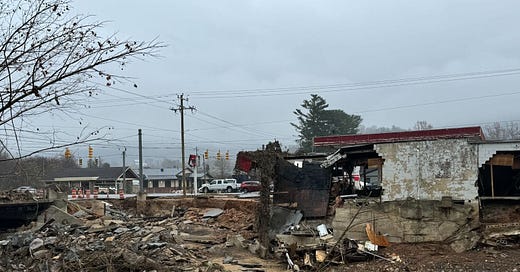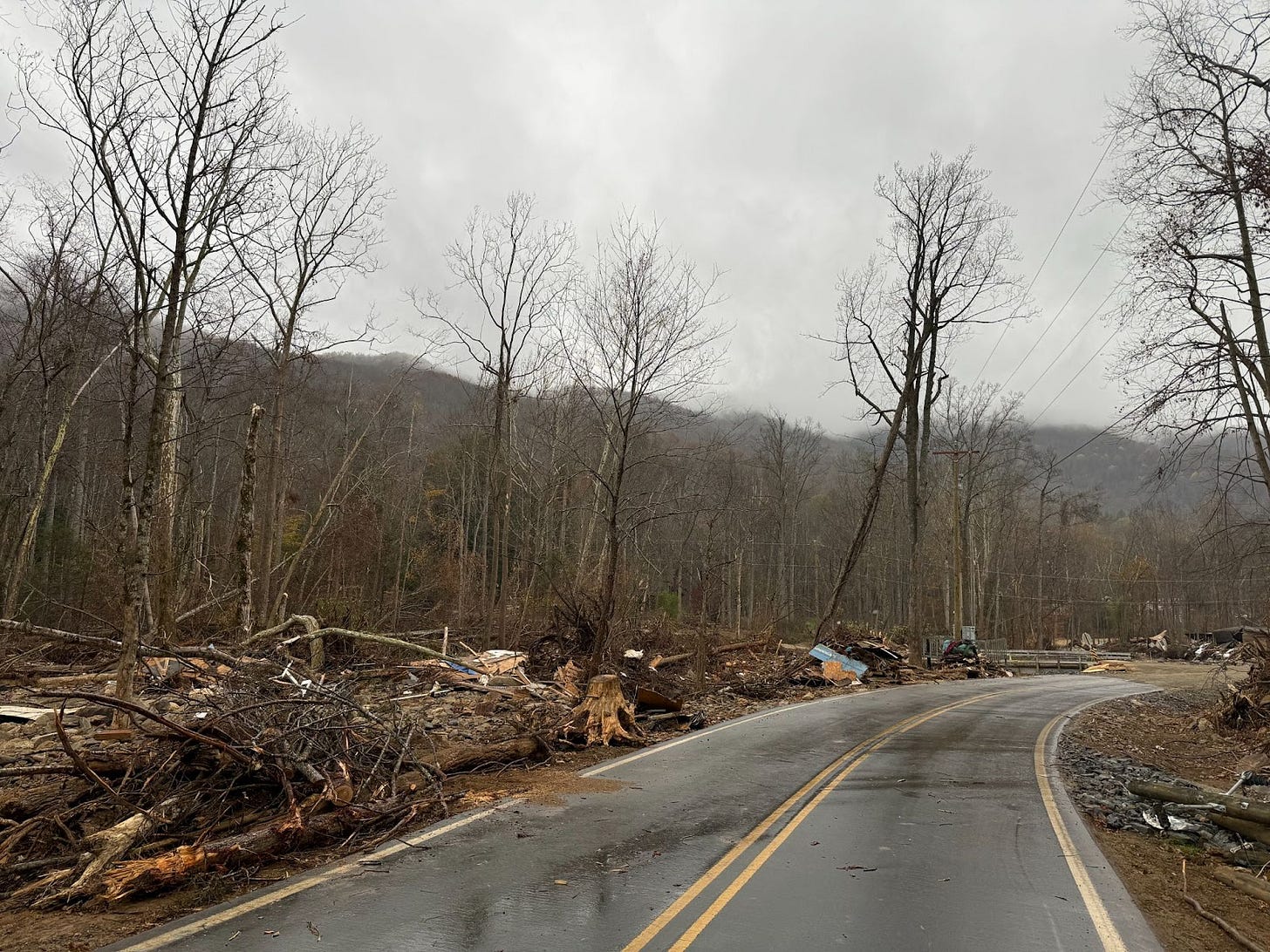On the outside, not much has changed
Plus: Third Helene relief package on the way; Woman dies after bypassing I-40 closure sign; Over 1,500 Buncombe County residents still live in hotels; Grove Park Inn to reopen Friday
You’re reading Mountain Updates, a free pop-up newsletter from The Charlotte Ledger examining the crisis and recovery in the N.C. mountains. Ledger subscribers can add Mountain Updates on their “My Account” page.
Sign up for free:
Much of Swannanoa this weekend (above) looked similar to the way it did in the immediate aftermath of the storm. Flooding from the Swannanoa River, pictured above among the debris, destroyed businesses and homes that sit between US-70 and the river, like an old gas station. The water level rose to nearly the top of the building. This photo was taken on Sunday, Nov. 10.
Driving through some of the hardest hit areas in Western North Carolina this weekend, it’s hard to believe that most of the damage and debris looks the same as it did six weeks ago after Helene.
But as my family and I drove down a few backroads in Swannanoa on Sunday, every turn brought a gasp and the questions “Who is going to clean up all of this debris?” and “Where are they going to move it?”
The “debris” in question consists of people’s belongings, barely identifiable among the mud, downed trees, power lines, random metal scraps and the occasional mangled vehicle or entire trailer that was uprooted and swept away by floodwaters. Six weeks later, it’s all still there.
Piles are still scattered along the roads and riverbanks, or in some places, still sit in the middle of the road, blocking traffic and forcing a total reroute to get to parts of town just on the other side — like a couple of rail cars blocking the bridge at the intersection of South Tunnel Road and Swannanoa River Road in Asheville.
Piles of debris have been pushed to the sides of roads, like Bee Tree Road pictured above, with no indication of when it will be picked up.
That’s not to mention the gutted buildings that look like they’ve been abandoned for years, not weeks. Orange, sprayed-painted X’s are on the sides of houses and cars that have been searched and deemed unsafe, some of which have numbers written below the X indicating the number of bodies found inside. Land that used to hold houses is now inhabited by camping tents and camper vans.
“I think we’re going to have to get used to it,” I told my mother. It’s hard to wrap my head around the manpower and resources it’s going to take to clean everything up, let alone repair and rebuild what’s still standing.
Bee Tree Christian Church in Swannanoa was gutted by Hurricane Helene. The church sits about a mile below the Bee Tree Reservoir, a 39-acre lake that’s currently full of sediment. The orange spray paint on the church means that the building has been deemed unstable and that no bodies were found inside by rescue and recovery teams. The church posted a photo immediately following the storm on its Facebook.
But I noticed a few differences compared with a month ago. Most military personnel have left the area. There are fewer helicopters bringing in supplies or searching for missing people. Some of the supply and hot meal distribution sites that were in full force have died down or no longer exist. Schools are open again, as are some businesses — although clean water remains elusive. Portable shower trailers have popped up around town.
I’m not sure if some of these differences are a sign of progress, or if it’s a sign that folks are just accepting the situation and learning to live in this new normal.
Regardless, Western North Carolina is still in great need. The true normal is a long way away.
Here’s the latest news since Friday’s Mountain Updates:
Third Helene relief package in the works: State Sen. Tim Moffitt confirmed discussions are underway for a third relief package focused on direct support for businesses and individuals affected by Helene. At a recovery forum on Nov. 8, Moffitt, Gov. Roy Cooper and local officials discussed needs like housing, a direct cash program and significant infrastructure repairs. (WLOS)
Woman dies after driving off I-40 in Haywood: A 62-year-old woman from Southern Pines died after bypassing “Road Closed” signs on a damaged section of I-40 in Haywood County. She mistakenly drove the wrong way on the interstate, eventually plunging into the Pigeon River Gorge. Rescuers extracted her from the vehicle, and she was airlifted to a Tennessee hospital, but she succumbed to her injuries. (WLOS)
North Fork Reservoir update: Although North Fork Reservoir’s water clarity has improved and residents are noticing clearer tap water, it remains non-drinkable because there is still too much sediment. The goal is to provide drinkable water by mid-December. The North Fork Reservoir is the source of water for 160,000 people in Buncombe and Henderson counties. (WLOS)
1,500 remain in hotels in Buncombe: In Buncombe County, over 1,500 residents displaced by Helene are still in hotels as officials explore long-term housing options. FEMA, in collaboration with local agencies, is assessing 400 potential sites, primarily commercial properties, for temporary housing, including manufactured homes. Plans may include a “group site” for multiple units, though there’s no set timeline for completion. FEMA continues to cover fair-market hotel rates to ensure residents have accommodations, especially with tourist season approaching. (Asheville Citizen Times)
Avery County lost one of its only dental clinics: Avery County’s only low-cost dental clinic, Avery Dental, was severely flooded, which has left residents with limited access to dental care. Many in the low-income community rely on the clinic, which is operated by the nonprofit High Country Community Health and offers sliding-scale fees and accepts Medicaid. Following the storm, High Country set up a temporary mobile unit to provide basic dental services while the clinic undergoes an estimated $500,000-$750,000 rebuild. (NC Health News)
Checking in on Watauga: Watauga County reported extensive damage, with over 1,100 buildings affected and 220 water rescues conducted. The storm triggered over 2,000 emergency calls. Now in the recovery phase, local and state agencies, alongside volunteer organizations, are focused on long-term efforts like home repair and debris removal, with community rebuilding expected to take years. (Watauga Democrat)
Tree loss: Millions of trees were downed during Helene in Western North Carolina, likely to take decades to recover. The Washington Post published an article with aerial maps and images showing the full extent of the damage.
Biltmore Estate welcomes tourists: Asheville and nearby areas, including the Biltmore Estate, are gradually reopening to tourists. Biltmore reopened on Nov. 2 with holiday decorations attracting visitors, but many businesses still face challenges, such as Asheville’s ongoing water issues, prompting some to truck in water and use disposable dishes. Local leaders, including Gov. Roy Cooper, encourage tourists to return and help boost the economy, which saw $3B from visitors in 2023. (Asheville Citizen Times)
Grove Park Inn set to reopen: The Omni Grove Park Inn in Asheville will reopen on Friday, Nov. 15, according to its website. Its spa, golf course and sports complex have already reopened, though the 32nd Annual National Gingerbread House Competition was canceled due to the storm.
Oprah recommends Asheville chocolatier: An Asheville chocolate company, French Broad Chocolate, has been named to Oprah’s Favorite Things list, which showcases gifts recommended by Oprah Winfrey. The company’s founder says it could help make up for lost sales of $1.5 million attributable to the dropoff in tourism. Oprah is recommending the “French Broad Classic Hot Chocolate Collection,” with three decorative canisters of hot chocolate mix, which retails for $54 at frenchbroadchocolates.com. (Asheville Citizen Times)
—
Lindsey Banks, a native of the Buncombe County town of Swannanoa, is a staff reporter with The Charlotte Ledger. Reach her at lindsey@cltledger.com.
How to help
Many organizations have deployed groups across the region, tasked with distributing food, water and supplies. You can donate to their efforts at the links below.
Hearts with Hands, a local disaster relief organization, has a donation page to provide food, supplies and water.
United Way of North Carolina has established a fund to help residents affected by the flooding.
MANNA Foodbank, which serves 16 counties in Western North Carolina, is accepting food, supplies and monetary donations. The organization’s warehouse on Swannanoa River Road in Asheville was damaged by the hurricane.
The American Red Cross is accepting donations to help residents in the Southeast.
Samaritan’s Purse, which is headquartered in Boone, is scheduling volunteers to help with debris cleanup.
Operation Blessing has a donation page to provide food, supplies and water.
E4E Relief, a Charlotte-headquartered provider of emergency financial relief programs on behalf of corporations, is accepting donations for their newly established Hurricane Helene Community Fund, offering financial support to individuals with long-term impacts from Hurricane Helene.
Need to sign up for this e-newsletter? We offer a free version, as well as paid memberships for full access to all of our local newsletters:
➡️ Opt in or out of different newsletters on your “My Account” page.
➡️ Learn more about The Charlotte Ledger
The Charlotte Ledger is a locally owned media company that delivers smart and essential news through e-newsletters and on a website. We strive for fairness and accuracy and will correct all known errors. The content reflects the independent editorial judgment of The Charlotte Ledger. Any advertising, paid marketing, or sponsored content will be clearly labeled.
Like what we are doing? Feel free to forward this along and to tell a friend.
Social media: On Facebook, Instagram, Twitter and LinkedIn.
Sponsorship information/customer service: email support@cltledger.com.
Executive editor: Tony Mecia; Managing editor: Cristina Bolling; Staff writer: Lindsey Banks; Business manager: Brie Chrisman







